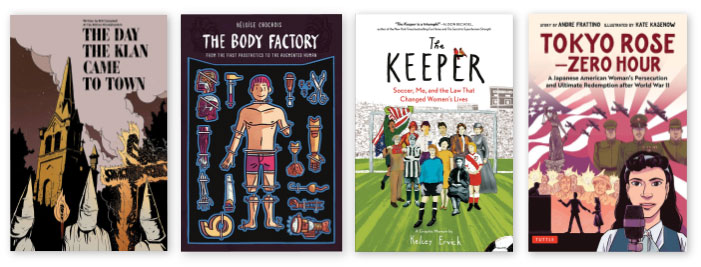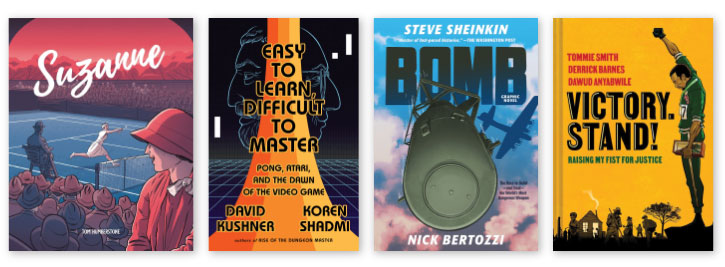Eight Graphic Works that Offer Fresh Perspectives on the Past | Stellar Panels
Including fiction, nonfiction, and memoir, these titles cover topics from the making of the atomic bomb to the history of video games.
 History is written by the victors, the old saying goes, but as Bill Campbell points out in The Day the Klan Came to Town, that means a lot of stories get left out altogether. Campbell grew up in the town of Carnegie, PA, but didn’t learn until much later that a Klansman had been killed on the steps of the church he and his family had attended there. He dug in, found the story, and turned it into a graphic novel.
History is written by the victors, the old saying goes, but as Bill Campbell points out in The Day the Klan Came to Town, that means a lot of stories get left out altogether. Campbell grew up in the town of Carnegie, PA, but didn’t learn until much later that a Klansman had been killed on the steps of the church he and his family had attended there. He dug in, found the story, and turned it into a graphic novel.
The past is not only prelude, but also the source material for a new wave of historical graphic novels. In many ways, the comics medium is perfect for conveying history: the action is immediate, and the characters and settings are right there on the page, no descriptions needed. On the other hand, graphic novels are a narrative medium, and history doesn’t always fit neatly into a story. Some creators frame their work by looking at a particular moment in a subject’s life, while others introduce fictional characters or compress time to make the story flow. To compensate, many of these books include bibliographies or afterwords to offer context and guide the interested reader toward more writings on the subject.
Here are eight graphic novels that feature timeless stories of bravery, ingenuity, and persistence, alongside new perspectives on the past—and the present. While many of these titles were originally published for adults, their fresh vantage points on frequently covered time periods carry crossover appeal for teens.

Campbell, Bill. The Day the Klan Came to Town. illus. by Bizhan Khodabandeh. PM Pr. Aug. 2021. ISBN 9781629638720.
Gr 10 Up–The Ku Klux Klan came to Carnegie, PA, in 1923 with an expanded mandate: to intimidate not only Black and Jewish people but also Catholics, Irish, Italians, and anyone else who was not white and Protestant. Their march through town was facilitated by the police chief, and the local burgess couldn’t do much about it, so the people of Carnegie took matters into their own hands and beat the Klan back themselves. Campbell tells the story from the point of view of Primo, a Sicilian immigrant who fled Fascism in Italy, as well as a diverse supporting cast. The immigrants are fictional characters, but Primo is carefully researched. Khodabandeh’s art has a blocky feel reminiscent of woodcuts, and he uses overlapping figures and repeated motifs, such as the Klansmen’s hoods, to create tension. The violence presented on the page makes this more suitable for mature teens, and there is one scene with nonexplicit nudity, as Primo and his fellow workers in a Sicilian mine did their work in the nude. P. Djèlí Clark, author of The Black God’s Drums, provides historical context in a foreword.
Chochois, Héloïse. The Body Factory: From the First Prosthetics to the Augmented Human. illus. by author. Graphic Mundi. Jul. 2021. ISBN 9780271087061.
Gr 8 Up–A young man loses his arm in a motorcycle accident, and as he recuperates, the ghost of renowned surgeon Ambroise Paré appears to him and leads him through the history of amputation, the neurology of the phantom limb, the development of prosthetics, and the future of artificially augmented bodies. In between these four chapters are wordless black-and-white sequences in which the young man recovers from his injury, copes with phantom limb as well as the emotional consequences, and learns to use his prosthetic arm. While the subject matter is not for the squeamish, Chochois uses a cartoony, upbeat style and a lighthearted tone. Injuries are depicted as simple shapes with a minimum of gore, although some of the anatomical sections, such as the depiction of the steps in amputating an arm, are more detailed. Readers may find the section on the neurology of pain a bit too technical, and the discussion of transhumanism at the end somewhat bewildering, but the rest of the book is entertaining and a fascinating read.
Ervick, Kelcey. The Keeper: Soccer, Me, and the Law that Changed Women’s Lives. Avery. Oct. 2022. ISBN 9780593539187.
Gr 10 Up–Ervick’s book combines memoir, meditation, and the history of soccer-playing women as well as the law, Title IX, that opened up opportunities for female athletes. Using her own experiences as a framework, and a video of her team as source material, Ervick depicts herself not just playing soccer but becoming part of the team, dealing with bad hair, troubled friendships, and even a beloved coach who turned out to be preying on some of the other women on the team. She also tells the stories of early women soccer players, and a few men, including Vladimir Nabokov, who was a goalie when he was at Cambridge University. Ervick’s loose, sketchy art is arranged across the page in borderless vignettes, with hand-lettered text winding between them, and her colorful style gives the historic figures and scenes a feeling of freshness. This book is about more than soccer, feminism, or writing; it’s a delightful blend of all three.
Frattino, Andre. Tokyo Rose – Zero Hour: A Japanese American Woman’s Persecution and Ultimate Redemption After World War II. illus. by Kate Kasenow. Tuttle. Sep. 2022. ISBN 9784805316955.
Gr 9 Up–The tale of Tokyo Rose, a Japanese radio broadcaster who taunted American troops to break their morale, plays into Orientalist stereotypes, but the reality is very different. While Japan had several radio broadcasters during World War II, the only one to be tagged as Tokyo Rose was a Japanese American woman, Iva Toguri, who was trapped in the country when she went to visit relatives just before the war. Not only did she refuse to renounce her American citizenship, she actively subverted their propaganda program, working with an American prisoner of war to produce programs that satisfied their Japanese supervisors but left the Americans snickering. After the war, a vindictive journalist led a crusade against her, and she was tried in the U.S. on charges of treason. The jury convicted her on a single charge, dismissing seven others, and it was later revealed that several key witnesses perjured themselves. In 1977, then President Gerald Ford granted her a full pardon. The lively black-and-white art, which recalls the style of editorial cartoons and illustrations of the era, is a perfect complement to the story, which focuses on Toguri’s spirit and determination in the face of hostility from both her home country and the one where she was an unwilling resident.

Humberstone, Tom. Suzanne: The Jazz Age Goddess of Tennis. illus. by author. Avery Hill. Oct. 2022. ISBN 9781910395691.
Gr 9 Up –Humberstone uses a limited palette of brick red and slate blue, combined with deft linework and strikingly composed pages, to tell the story of French tennis star Suzanne Lenglen, from her teenage years being coached by her demanding father to her life as an international sensation. Lenglen was known both for the excellence of her play and the free-flowing outfits she played in (while her English competitors labored in corsets and long skirts). Humberstone shows her alternately enjoying her fame and resenting the life she must lead to maintain it, and he touches on Prohibition, women’s fashions, and the professionalization of women’s sports. His depictions of Lenglen and her opponents on the court are carefully paced and easy to follow even for those not versed in tennis, and he revels in intricate, immersive settings, including a promenade on the French Riviera, the Wimbledon tennis courts, and a jazz club in Harlem.
Kushner, David. Easy to Learn, Difficult to Master: Pong, Atari, and the Dawn of the Video Game. illus. by Koren Shadmi. Bold Type Bks. Sep. 2022. ISBN 9781568588766.
Gr 7 Up–Kushner and Shadmi set up their story as a battle between Ralph Baer and Norman Bushnell, two video game pioneers who may not be household names today but were key figures in their time. Baer developed a way to play games on television sets, which he sold to Magnavox; Bushnell used some of Baer’s ideas when he founded the game company Atari. Each tells their story in a different color, Baer in purple and Bushnell in aqua, while their clashes are in black and white. The art is straightforward, except in the game sequences, when it gets more dramatic. As a result, readers learn quite a bit about the history of video games, as well as some of the cultural nuances, in this slim volume.
Sheinkin, Steve. Bomb (Graphic Novel): The Race to Build—and Steal—the World’s Most Dangerous Weapon. illus. by Nick Bertozzi. Roaring Brook. Jan. 2023. ISBN 9781250206749.
Gr 4-6–This graphic adaptation of Sheinkin’s 2012 nonfiction title follows multiple time lines, as scientists in Germany, the United States, and Russia race to develop an atomic bomb; two different spies leak atomic secrets to the Russians; and a group of Swedish saboteurs destroy the Germans’ facilities. The framing tale is the 1950 interrogation of a real spy, Harry Gold, by two wisecracking FBI agents in fedoras and suspenders. As Gold recounts his actions, the agents narrate other parts of the story, and readers see the scientists first exhilarated by the new discoveries, then convinced they would save the world from the Nazis, then reflecting on the terrible legacy of their work, in terms of both lives lost and the lasting legacy of the nuclear arms race. Bertozzi tells this complicated story with uncluttered panels, easy-to-follow page compositions, and an artistic sensibility that harks back to classic crime comics, keeping the action flowing so the story never bogs down.
Smith, Tommie & Derrick Barnes. Victory. Stand! Raising My Fist for Justice. illus. by Dawud Anyabwile. Norton. Sept. 2022. ISBN 9781324003908.
Gr 8 Up–Smith and his teammate John Carlos electrified the 1968 Summer Olympics with a single gesture: when Smith received his gold medal, and Carlos his bronze, they stood on the podium shoeless, with fists raised, to protest the treatment of Black people in America. Much of Smith’s backstory—his upbringing as the son of a Texas sharecropper, his experiences at San Jose State, which he attended on a sports scholarship, and the growth of the Civil Rights movement throughout the country—is told in flashbacks during that Olympic race, which he won despite an injury. In the years after that pivotal moment, Smith endured unemployment and death threats, followed by eventual recognition and ultimately, celebration of his actions. Anyabwile’s black-and-white art uses strong lines to convey both emotion and speed, and his runners often break out of the panels altogether.
Brigid Alverson founded the blog “Good Comics for Kids.”
RELATED
The job outlook in 2030: Librarians will be in demand
The job outlook in 2030: Librarians will be in demand
ALREADY A SUBSCRIBER? LOG IN
We are currently offering this content for free. Sign up now to activate your personal profile, where you can save articles for future viewing






Add Comment :-
Be the first reader to comment.
Comment Policy:
Comment should not be empty !!!